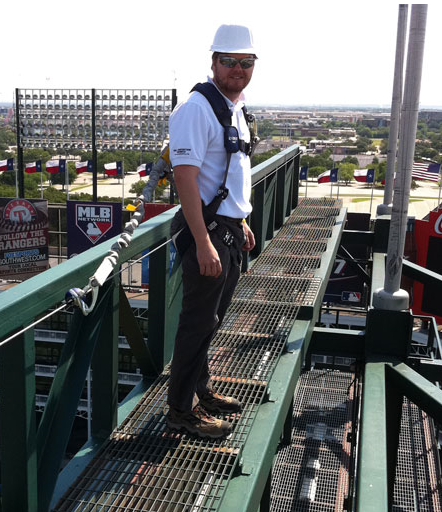Stadium, Arena, and Convention Center Fall Protection
Installation and removal of banners and flags as well as score board and lighting maintenance in stadiums, sports arenas, and convention centers is hazardous work that requires fall protection. Although maintenance tasks performed in these market segments may seem far removed from the types of industries subject to routine OSHA safety inspections, stadiums, arenas, and convention centers are held to many of the same fall protection standards as the industrial sector. Ensuring the safety of your employees requires the implementation of a comprehensive fall prevention strategy, which includes the proper mix of fall protection equipment, personnel training, and partnering with a fall protection company that appreciates the unique nature of your facility’s access points and potential fall hazards.

Stadiums, Arenas, Convention Centers

Stadiums, Arenas, Convention Centers
We are a complete turnkey provider of OSHA compliant fall protection systems and have years of design and installation experience in these market sectors. Contact us for expert assistance with your fall arrest, fall restraint and fall protection safety requirements
Fall Protection Solutions
-
Catwalks
View Catwalks -
Horizontal Lifelines
View Horizontal Lifelines -
Rescue and Descent Systems
View Rescue and Descent Systems -
Fall Protection Anchors
View Fall Protection Anchors -
Temporary Systems
View Temporary Systems -
Vertical Lifelines and Ladder Systems
View Vertical Lifelines and Ladder Systems
Design Considerations
Stadium, Arena, and Convention Center Fall Protection Design Considerations
One of the main themes when designing fall protection systems for outdoor stadiums is the corrosive effects associated with continuous exposure to the elements. Horizontal lifelines, single point anchors, beam gliders, and other fall arrest systems used to protect maintenance personnel in these market sectors must be constructed from stainless steel to provide maximum corrosion resistance. Special care must be taken when working in stainless because this material does not have the same mechanical properties as carbon steel. For this reason, fall protection systems and their respective components must be constructed from heavier gauge materials to prevent catastrophic failure.
The beams and ceiling grid systems associated with indoor arenas and convention centers are particularly well suited for horizontal lifelines as a means of fall arrest. Effective system design a must accommodate multiple users and arrest falls before workers strike structure beneath the work area.
Whether the fall arrest application is indoors or outdoors, systems designed for stadiums, arenas, and convention centers typically cover long spans. A continuous pass through horizontal lifeline system provides excellent coverage in terms of length and changes in direction.
It is also important to have systems that allow for long spans of fall protection in this market segment. Our continuous pass through horizontal lifeline system provides excellent coverage in terms of length and changes in direction.
DFP has years of experience designing and installing fall protection systems specifically tailored for each of your facility’s hazardous areas. Our understanding of your unique access points and fall hazards, combined with our turnkey approach to OSHA compliant fall protection will keep both your guests and employees safe.
OSHA Regulations
- 1926.502(d)
‘Personal fall arrest systems.’ Personal fall arrest systems and their use shall comply with the provisions set forth below. Effective January 1, 1998, body belts are not acceptable as part of a personal fall arrest system. Note: The use of a body belt in a positioning device system is acceptable and is regulated under paragraph (e) of this section. - 1926.502(d)(8)
Horizontal lifelines shall be designed, installed, and used, under the supervision of a qualified person, as part of a complete personal fall arrest system, which maintains a safety factor of at least two.
- SPA
- 1926.502(d)(15)
Anchorages used for attachment of personal fall arrest equipment shall be independent of any anchorage being used to support or suspend platforms and capable of supporting at least 5,000 pounds (22.2 kN) per employee attached, or shall be designed, installed, and used as follows: - 1926.502(d)(15)(i)
as part of a complete personal fall arrest system which maintains a safety factor of at least two; and - 1926.502(d)(15)(ii)
under the supervision of a qualified person.
- 1926.502(d)(15)
Talk to a fall protection specialist
Tell us about your fall protection needs, and we’ll configure a system that rises to your challenges.

